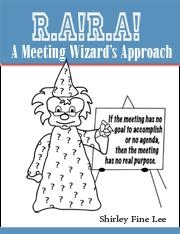|
This bimonthly
e-news is made available
to further the mission:
�
�To
help organizations increase employee and system potential to produce
results.�
�
�
�
�
�
We encourage sending this to others so they may benefit from the information
provided.�
�
If you know others who would like to subscribe to this newsletter, please
forward this issue so they may
click here to subscribe.
�
To
remove your name from e-mail list,
click here to unsubscribe.
�
To
review past newsletters,
click here for archives. � If you would like to reprint
an article or have a similar article written for your newsletter, please contact
the newsletter editor.
� � � � � �
Providing:
Classroom Delivery,�
Communication Publishing,
Consulting Services,
�Instructional Design,
Meeting Facilitation,
Newsletter Articles,
Productivity Training,
Seminar Speaking,
System Support,
and Team Building.
�

�
Copyright 2007
Shirley Lee
All Rights Reserved
www.ShirleyFineLee.com |
According to The Book
of Lists by Wallechinsky and Wallace, the fear of public
speaking ranks above the fear of death and disease as number one in the
minds of the majority of people.
�
When preparing a
presentation, consider using the four P�s of action to help you with your
structure.� The four action P�s are:� Plan, Prepare, Practice, and Perform.
1.� Plan
- Consider your audience
and why you are giving the presentation.� What appeals to them and why do
they want to know about your subject?�
- How much time do you
have and what type of visual aids may be relevant and usable at the
location of final presentation.
2.� Prepare
- Start with the beginning
and ending, and then add the detail in the middle that supports your
strong start and end.�
- How can you make the
presentation memorable?� Now that you know what to say, develop any
visuals that may accompany the presentation making sure their flow matches
the presentation.� You don�t want people fumbling with handouts or noting
spelling errors when they could be listening.
3.� Practice
- Rehearse the
presentation out loud and time yourself giving it to make sure you can get
your main points across in the time allotted and that it flows well.� If
not, revise your presentation.� This also gives you the opportunity to
determine where to add speech emphasis, use hand gestures, or add in a
pause for effect.
- Practice again with
someone observing.� Ask the observer to give you honest feedback to
improve your presentation.�
- If possible, plan time
to practice in the actual setting for the presentation.� This allows you
to find potential problems and find a work-around before the presentation.
4.� Perform
- Be sure you have an
introduction prepared so if you are not introduced, you can give your own
name and credentials.�
- Don't read directly off
your visuals or try to memorize the entire presentation. Know your subject
well and let it flow naturally.�
- Since you practiced, you
will be confident and should be able to avoid too many um�s and uh�s,
grasping the podium, or putting hands in your pockets.�
-
Don�t forget to thank
the audience for their time or make some statement that let�s them know
you are closing.�
NOTE:� A
form for developing a presentation plan is available on pages 12-13 of the
book "R.A!R.A! A Meeting Wizard's Approach" or by emailing
Shirley Lee
.�
�
Visuals vastly improve the
chances that your audience will get the message and handouts increase
retention afterwards.� Remember text-based visuals should be used to emphasize key points
only, not as a replacement for talking time whereas handouts may include
detailed notes or items the audience may wish to investigate later.� Also when developing visuals, consider that a picture
is worth more than words. With all the great software options on the market
today your presentations can be enhanced with graphs, photos, clip art and
sound.
�
To improve speaking
skills, join a group that will allow you to practice while learning key
elements of good presentation.� Also, using a evaluation at the end of
a presentation is a great way to find out what people really think and get
suggestions for improvement.� For a sample briefing
evaluation,� check out
http://www.shirleyfinelee.com/FreeForms.htm.
�
"It
usually takes more than three weeks to prepare a good impromptu speech. " -
Mark Twain
|
R.A!R.A! A Meeting Wizard's Approach
BOOK SUCCESS
�
Recent book
reviews and recommendations have been published by:
�

�
ISBN:
1-4196-5367-9
�
Order book on
www.Amazon.com,
www.Borders.com,�
www.Target.com,
or thru local bookstore.
�
�
�
�
KEYNOTE
SPEAKER
AVAILABLE!
�

�
The Meeting Wizard has openings on her calendar
to speak at seminars, meetings, or Lunch N Learns.�
�
Contact Shirley Lee
at 214-457-5736
�
Topics include:
|